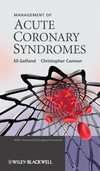Management of Acute Coronary SyndromesISBN: 978-0-470-72557-3
Hardcover
238 pages
May 2009
 |
||||||
List of contributors xiii
Foreword xv
Eugene Braunwald
Chapter 1 Pathophysiology of acute coronary syndromes
1
Alisa B. Rosen and Eli V. Gelfand
Introduction 1
Formation of atherosclerotic plaque 2
Plaque instability and the development of ACS 5
Myocardial ischemia 7
Thrombus formation 7
Platelets 7
Secondary hemostasis 9
Dynamic obstruction 10
Progressive mechanical obstruction 10
Inflammation 11
Secondary unstable angina 11
References 11
Chapter 2 Diagnosis of acute coronary syndrome 13
Eli V. Gelfand and Alisa B. Rosen
Introduction 13
Definition of myocardial infarction 13
History 14
Risk factors 17
Physical examination 17
Electrocardiography 19
The pathophysiologic basis of ST segment
changes during ischemia 19
Electrocardiography in ST-elevation MI and identification of the infarct-related artery 20
Electrocardiography in unstable angina and NSTEMI 26
Cardiac biomarkers 26
Noninvasive imaging 29
Echocardiography 29
Myocardial perfusion imaging 30
Coronary computed tomography 30
Cardiovascular magnetic resonance imaging 31
Stress testing for diagnosis of ACS 32
Overall diagnostic pathway for ACS 32
References 34
Chapter 3 Unstable angina and non-ST-elevation myocardial
infarction 37
Eli V. Gelfand and Christopher P. Cannon
Introduction 37
Causes of UA/NSTEMI 37
Presentation of UA/NSTEMI 38
General strategies in management of UA/NSTEMI 39
Risk stratification of patients with UA/NSTEMI 40
Initial management of UA/NSTEMI in the emergency department 42
Pharmacologic treatment of ischemia in UA/NSTEMI 43
Beta-blockers 44
Nitrates 44
Calcium channel blockers 45
Angiotensin-converting enzyme inhibitors 45
Morphine 46
Oxygen 46
Invasive versus conservative strategy 46
Antiplatelet therapy in UA/NSTEMI 49
Aspirin 54
Clopidogrel 55
Prasugrel 57
Glycoprotein IIb/IIIa inhibitors 58
Anticoagulant therapy in UA/NSTEMI 61
Unfractionated heparin 61
Enoxaparin 62
Direct thrombin inhibitors 65
Fondaparinux 66
Oral anticoagulation in UA/NSTEMI 67
Fibrinolysis in UA/NSTEMI 68
Early lipid-lowering therapy in patients with UA/NSTEMI 68
Predischarge noninvasive risk stratification after UA/NSTEMI 69
Overall management of UA/NSTEMI 71
References 71
Chapter 4 ST-segment-elevation myocardial infarction
79
Eli V. Gelfand and Christopher P. Cannon
Introduction 79
Global treatment goals in STEMI 79
Prehospital management and triage 80
Transport decisions 82
Management prior to reperfusion 82
Primary reperfusion therapy for STEMI 83
Fibrinolysis 83
Combination fibrinolysis 86
Markers of fibrinolysis effectiveness 86
Complications of fibrinolysis 88
Primary percutaneous coronary intervention 88
Comparison of PCI with fibrinolysis 90
Timing of primary PCI 91
PCI following fibrinolytic therapy 94
Rescue PCI 94
Facilitated PCI 94
Routine PCI after successful fibrinolysis 96
Overall reperfusion strategy 97
Coronary artery bypass grafting for treatment of STEMI 98
Adjunctive pharmacologic treatment of STEMI 98
Antiplatelet agents 98
Anticoagulation therapy 101
Other adjunctive therapy 105
Hospital care following successful reperfusion 110
References 114
Chapter 5 Special considerations in acute coronary syndromes
123
Jason Ryan and Eli V. Gelfand
Secondary unstable angina 123
Acute coronary syndrome in patients with diabetes mellitus 123
General considerations 123
Primary ACS therapy in diabetics 124
Glycemic control in diabetics with ACS 125
Coronary revascularization in diabetics 126
Metabolic syndrome and ACS 127
Chronic kidney disease in ACS 127
Young patients with ACS 130
ACS in the setting of cocaine use 130
ACS in patients with normal coronary arteries or mild CAD 132
Myocarditis 132
Acute transient apical ballooning syndrome 133
Postoperative ACS 134
ACS in a pregnant woman 135
Hyperthyroidism and ACS 136
ACS in patients exposed to radiation 137
Trauma and ACS 137
References 137
Chapter 6 Complications of acute coronary syndrome
141
Jan M. Pattanayak and Eli V. Gelfand
Introduction 141
Pump failure 141
General principle 141
Clinical presentation 142
Prognosis 144
Treatment 144
Right ventricular infarction 148
Introduction 148
Clinical presentation 148
Diagnosis 149
Management 150
Prognosis 152
Mechanical complications of ACS 152
Introduction 152
Left ventricular free wall rupture 152
Ventricular septal rupture 153
Acute mitral regurgitation 154
Left ventricular aneurysm 155
Left ventricular pseudoaneurysm 157
Pericardial complications 157
Arrhythmic complications of ACS 159
Bradyarrhythmias 159
Atrial fibrillation 163
Ventricular tachycardia and fibrillation 163
Complications involving bleeding 164
Complications of percutaneous coronary intervention 165
References 170
Chapter 7 Post-hospitalization care of patients with acute
coronary syndrome 173
Jersey Chen and Eli V. Gelfand
Introduction 173
Pharmacologic measures 173
Aspirin 173
Clopidogrel 174
Beta adrenergic blockade 177
Renin–angiotensin–aldosterone inhibitors 179
Lipid-lowering therapy 185
Warfarin 189
Influenza vaccination 192
Medications of limited benefit to patients following ACS 192
Vitamins/antioxidants 192
Estrogen replacement therapy 192
Nonsteroidal anti-inflammatory agents and related compounds 194
Nonpharmacologic measures 195
Antiarrhythmic devices 195
Therapy of comorbidities following ACS 198
Diabetes mellitus 198
Hypertension 199
Depression 199
Lifestyle recommendations following ACS 200
General physical activity and structured cardiac rehabilitation 200
Sexual activity after ACS 201
Smoking cessation 201
Diet/nutrition and weight loss 202
References 204
Appendix 209
Index 217



